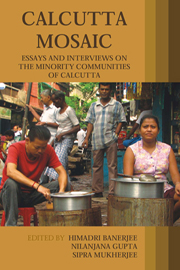Book contents
- Frontmatter
- Contents
- List of Contributors
- Acknowledgements
- Introduction
- 1 Mapping the Spaces of Minorities
- 2 The Armenians of Calcutta
- 3 The Jews of Calcutta: An Interview with Michael Ezra
- 4 The Sindhis of Calcutta
- 5 The City of Colleges
- 6 The Chinese Community of Calcutta
- 7 The Anglo–Indians of Calcutta
- 8 The Biharis of Calcutta
- 9 Agraharis of Calcutta
- 10 A Journey into My Neighbourhood
- 11 The ‘South Indians’ of Calcutta: Experiences in Cultural Processes
- 12 ‘Non-Bengali’ Icons of Malevolence
- 13 Selfing the City
12 - ‘Non-Bengali’ Icons of Malevolence
Middle Class Representation of an ‘Other’ in Interwar Calcutta
Published online by Cambridge University Press: 05 March 2012
- Frontmatter
- Contents
- List of Contributors
- Acknowledgements
- Introduction
- 1 Mapping the Spaces of Minorities
- 2 The Armenians of Calcutta
- 3 The Jews of Calcutta: An Interview with Michael Ezra
- 4 The Sindhis of Calcutta
- 5 The City of Colleges
- 6 The Chinese Community of Calcutta
- 7 The Anglo–Indians of Calcutta
- 8 The Biharis of Calcutta
- 9 Agraharis of Calcutta
- 10 A Journey into My Neighbourhood
- 11 The ‘South Indians’ of Calcutta: Experiences in Cultural Processes
- 12 ‘Non-Bengali’ Icons of Malevolence
- 13 Selfing the City
Summary
This article meets the central theme of the present volume from a relatively unusual direction. Instead of focusing directly on the ‘minorities’ in Calcutta in terms of their own respective subjectivities, it explores how the notion of ‘minority’ is significantly shaped by the way in which dominant groups in the city perceive themselves as the ‘majority’. Arguably, the ‘majority's’ self-projection is as crucial in the configuration of ‘minorities’ as the relatively objective parameters of demography and statistics. Again, if the minorities in Calcutta have historically and variously asserted their cultural differences and thus inscribed their signature on the configuration of minorities, there is a sense in which this configuration has been dialectically constituted by the ‘majority's’ discourse of power. Finally, a study of the ‘majority's’ discourse on the ‘minorities’ also brings out the role of cultural essentialism in translating the bare demographic–statistical fundamentals of a minority community's existence into majority communities' construction of the ‘other’.
The boundaries of the self-perception of the ‘majority’ in Calcutta may well vary depending on what the authors of the concerned discourse of power invoke as the crucial determinant of ethnicity – religion or language or a combination of both. Though discourses claiming a Hindu ‘majority’ for the city is common, the city is often also imagined as the site of an essential Bengali-ness.
- Type
- Chapter
- Information
- Calcutta MosaicEssays and Interviews on the Minority Communities of Calcutta, pp. 231 - 252Publisher: Anthem PressPrint publication year: 2009
- 1
- Cited by



